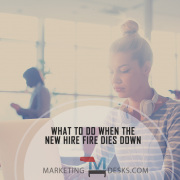Do You Really Treat Employees Like You Treat Your Best Customers?
If the way you treat employees is supposed to exemplify how you want your best customers to be treated, you might need to rethink the employee experience.
Why Should You Treat Employees Like You Treat Your Best Customers?
There are any number of quotes that advise business owners to treat employees as they would their best customers, and why:
“Always treat your employees exactly as you want them to treat your best customers.” – Steven R. Covey
“Success in business is all about people, people, people. Whatever industry a company is in, its employees are its biggest competitive advantage.” – Sir Richard Branson
“Keep your team satisfied by making sure they have great reasons to show up for work in the morning.” Shep Hyken
“People create memories, not things. The real value comes from the ladies and gentlemen who bring the hotel to life.” – Ritz Carlton customer service
“Customers will never love a company until the employees love it first.” – Simon Sinek
“Train people well enough so they can leave; treat them so well they won’t want to.” – Sir Richard Branson
“Treat employees like they make a difference and they will.” – Jim Goodnight
And perhaps the most well-known of all: “If you take care of your employees, they will take care of your customers, and your business will take care of itself.” – J.W. Marriott
In fact, J.W. Marriott even lays out a formula:
“Motivate them, train them, care about them, and make winners out of them. We know if we treat our employees right, they’ll treat the customers right. And if the customers are treated right, they’ll come back.”
Here’s the thing. A lot of business owners say it, but are they really doing it? If we really treated our employees like we treat our best customers, here are some of the things we might do (or do differently).
- Demonstrate added value and try to give them the best deal possible.
- Communicate continually as though our relationship depended on it, in person, in email, on social media, on our websites.
- With intention, live up to or even exceed expectations.
- Exercise patience.
- Optimize the physical environment (clean, pleasing, conducive, comfortable, etc.)
- Renew expiring agreements; for instance, are you holding employee reviews regularly and adjusting salaries?
- Accommodate schedules. Tailor options, add-ons and terms.
- Solicit feedback and ask for suggestions. Listen and respond to employee complaints as quickly as possible.
- Do what we can to make things right when things go wrong; and by extension, empower managers to make things right if things go wrong without having to get approval.
- Brainstorm new ways to keep them engaged and innovate.
- Proactively assess the employee experience at each touch point with the goal of making it as good as possible.
When you think about it in those terms, it’s clearly a tall order and not something that will happen by chance. Not to mention that all of this needs to occur in a way that is still practical for your company. If you hadn’t thought about the employee experience in these types of terms before, you may even be having some “A ha!” moments right now – you might be able to tie a so-so or sub-par employee experience back to lack of engagement, low morale, low productivity and lack of employee buy in.
If you’re looking for a formula, why not start with the one J.W. Marriott proposed? Let’s take a closer look at his advice on how to treat employees.
4 Ways to Treat Employees Like You Treat Your Best Customers
1. Motivate them.
Motivating people to take action is what marketing is all about, and to engage your employees, you need to adopt a marketing mindset. This is how you persuade them to do what you want them to do. This is how you “sell” them on company initiatives. This is how you get the type of buy-in that changes the way they do their jobs.
2. Train them.
No matter how bought-in and enthusiastic an employee is, if they don’t have the resources, tools, skills, and ability to do the work and do the work well, they will quickly become discouraged. They can’t pursue the vision if you don’t properly equip them.
3. Care about them.
When you’re getting to know a new customer, do you dive right in to business or spend time getting to know them? If you skip this discovery process you may find that you misread them and failed to identify what they truly needed. Customers don’t buy your products, they buy your solutions. People aren’t looking for work, they’re looking for solutions, too. They need income, but income isn’t the end, it’s the means to many different types of ends (paying bills, taking vacations, saving for retirement, putting kids through school, and so on). Caring for them entails your knowing what their pain points are, just as you do for your customers, so you can come up with the best solutions. Sometimes solutions that are uniquely tailored just for them!
4. Make winners out of them.
Do employees know how to “win” the game of work? Clear vision, goals, measures, difficult-but-doable (interesting, challenging) work, and a path to wins both big and small can all help motivate employees and keep them engaged. Customers feel like winners when they believe they received good value for their money; your employees feel like winners when they feel like they receive good compensation for the value they provide. Customers feel like winners when they believe they are important to you; employees do, too. Customers feel like winners when they are proud to introduce your business to others; employees do, too.
The good news is it’s never too late to start. If you want to treat employees like you treat your best customers, start with a list of your customer promises and customer service values, and make sure that you have a corresponding employee promise or value, and work with your leadership team to find ways to incorporate them into your company culture.
You might also like: 5 Places Organizational Culture Shows Up








Trackbacks & Pingbacks
[…] You might also like: Do You Really Treat Employees Like You Treat Your Best Customers? […]
Leave a Reply
Want to join the discussion?Feel free to contribute!